| 1 | Brown kukri snake |
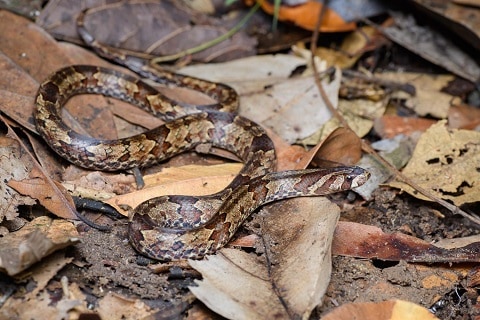
A non-venomous Singapore species which isn’t too short, at a maximum of 90cm, but still gets overlooked by chattering tourists. Brown kukri snakes (Oligodon purpurascens) dwell in forests, rarely urban areas. They like pristine spots, but even in nature reserves busy with tourists, most people walk right past them.
Brown kukri snakes are semi-fossorial and lurk in soft upper layers of soil, by burrowing with their head. With their brown colours, they effortlessly blend in. When exploring the surface, brown kukri snakes still stay below rocks or rotting logs. Every aspect of this Singapore species is fine-tuned to stay hidden. Whether it’s birds, monkeys or humans, they succeed with aplomb. They play by their own rules and stand well back from the battle fray.
This species has two morphs, which commonly overlap in the same forests. One is brown with darker brown bands, while the other is red with orange bands. The latter is slightly easier to spot while walking past, but brown kukri snakes are still slippery and stealthy, and their forests are colourful enough that they blend right in.
| 2 | Cox’s mud snake |
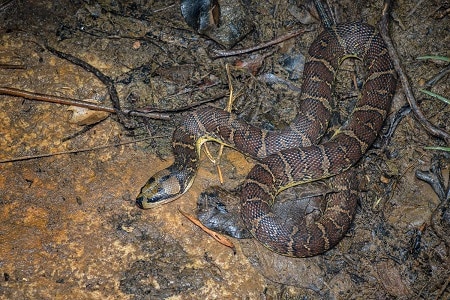
Cox’s mud snake is a Cambodian and Thai species which can reach 137cm. Their modus operandi is lurking in shallow pools to ambush prey, commonly resting immobile on the muddy shores. There, Cox’s mud snake becomes ever more covered in muck, ever more absorbed in the dark, muddy shoreline it rests on. The Cox’s mud snake becomes completely disguised, and only glaring eyes reveal their presence.
All this makes Cox’s mud snake (Homalopsis mereljcoxi) challenging to spot for a fisherman or simple villager walking past a lake. There isn’t one scale of green or bright blue on their bodies. It’s all grey and brown, to maximise their disguise. Cox’s mud snakes are thick bodied, yet still surprisingly easy to walk past. They also appear in shallow wetlands, where damp vegetation increases their disguise.
Cox’s mud snakes are harmless and common. They can move across land, but become sluggish and halting. Mud is what brings them alive, which unlocks all their powers of disguise, so that people can stray within 1 metre of them without ever realising it while they sit at home eating dinner a few hours later.
| 3 | Smooth snake |
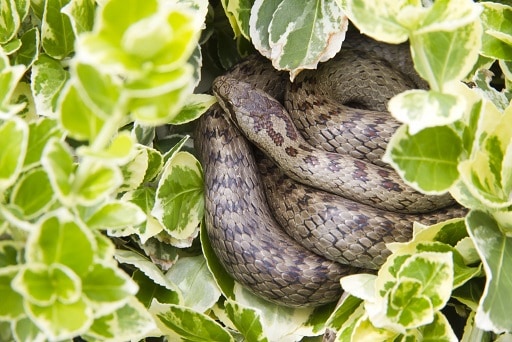
The third of three UK snake species, the one that few have heard of. Smooth snakes are harmless and live in a handful of countries: Dorset, Surrey, possibly Berkshire and Wiltshire. They’re endangered, increasingly rare, and found in narrow habitats. Even within confirmed habitats, the smooth snake is a nightmare to search for. They live in sweeping stretches of ferns and heather, with no trees, typically stretching miles into the distance. They could be in the centre of this inhospitable habitat, or just metres from your path, but even so, it’s incredibly easy to walk right past them.
Smooth snakes favour the most tangled sections of heathland above all. Their smooth scales evolved specifically to stop them from getting snagged. Smooth snakes avoid open spaces, and would rather weave through a neverending maze of thick roots and leaves.
Even their beige-brown patterns are optimised for blending into heathland, just as a grass snake’s are for ponds and fields. Smooth snakes also move slowly and patiently, so it’s unlikely that your eye will be caught by a sudden flicker of movement.
| 4 | Short-tailed alpine garter snake |
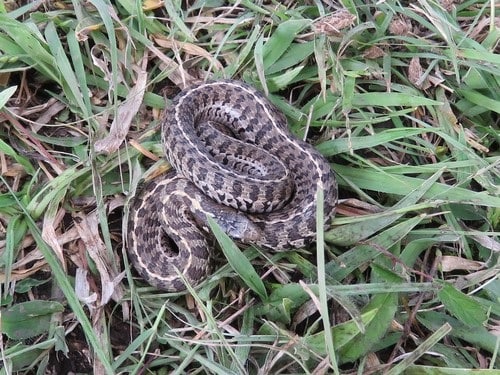
A 40-50cm cousin of the American garter snakes, found only in central southern Mexico. Thamnophis scaliger is abundant in the countryside surrounding Mexico City, and the valleys and villages of the entire plateau.
This species is found above 2100 metres in altitude, in scenic grassy spots with flowing streams and thriving horse pastures, rather than brown desert. They’re more recognisable than most garter snakes, with flanks containing dark blotches rather than stripes. But that doesn’t mean you’ll get to meet them. It doesn’t mean you’ll get to put your knowledge to the test, as Thamnophis scaliger is a shy species which likes to lurk under rocks or in long grass.
Thamnophis scaliger has no dangerous venom, and no razor sharp teeth. They have no intimidating, viper-mimicking patterns. They can’t compete with a hungry hawk, and they know it. Short tail alpine garter snakes prefer to stay hidden, and are slow-moving to make that happen. Even local herdsmen rarely see them. Just because farmers know their fields off by heart doesn’t mean they don’t unknowingly walk past snakes many days.
| 5 | Anderson’s stream snake |
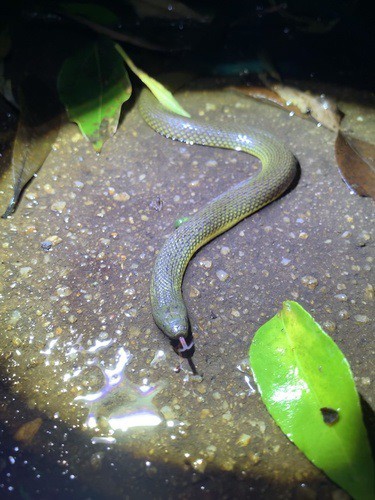
A grey-brown watersnake of Hong Kong and southern China. This is a thin and nimble swimmer rather than a bulky ambusher like Cox’s mud snake. This species bypasses cobra battles, cunning viper impersonation schemes, and has no desire to randomly leap onto people’s heads. Instead, they’re a humble stream snake, which is common in Hong Kong but rarely sighted.
Anderson’s stream snakes measure 30cm and are mildly venomous. Their world consists only of their lush stream and the surrounding banks. The dusty rattlesnake badlands of Mexico 1000s of miles away would be incomprehensible to them, but Anderson’s stream snakes have all they need to live their lives. With their non-flashy colours, it’s simple for Hong Kong citizens to walk over a small footbridge and not notice them swimming below. They might catch a small flash of something in the stream, before ruling it out as pure imagination.
Anderson’s stream snakes prey on shrimp, and keep themselves to themselves. They have round pupils and shiny grey scales, with pretty much no vibrant colours that could catch a passing walker’s eye. In the streams where they live, this is an abundant snake.
| 6 | Pale-headed snake |
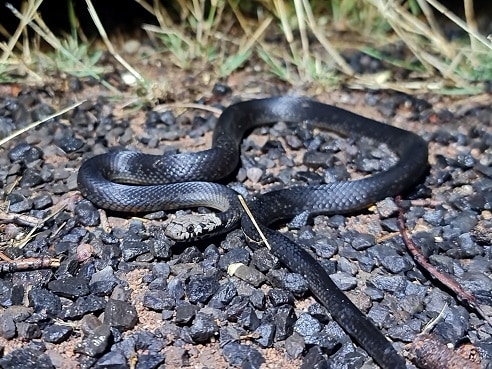
This species doesn’t have the most amazing camouflage, but stays hidden thanks to instinctively gravitating towards shelter. Hoplocephalus bitorquatus is a forest species of Australia, which occasionally appears in field next door, but requires some trees to survive. They max out at 90cm, and while they possess a sudden boost which allows them to escape dangerous situations, they generally move slowly and deliberately.
Despite their eye-catching white head, which contrast vividly with their black body, pale-headed snakes have better camouflage than you’d expect. They have a particular liking for old, hollow tree logs, even hollow dead trees, and they correlate most closely with such areas. Experts know how to search in these dens, but the average person will walk right past the pale-headed snake, their hunger for snake encounters still unsatisfied. This is a moderately venomous species which contains neurotoxins, but probably in too small doses to hurt humans. No deaths have been recorded.
Pale-headed snakes are always careful to keep their name out of newspapers. They don’t wash into houses during floods and attack people, or get their heads stuck in postboxes and necessitate a rescue. Thus they avoid drawing attention to themselves, meaning that nobody knows to look for them, even if they enter the correct forest. This species mainly lives on Australia’s east and northeast coast.
| 7 | Smooth green snake |
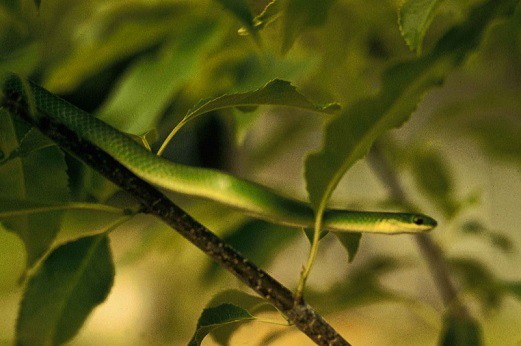
Just because a snake is well disguised doesn’t mean they fit our criteria. They still have to live near civilisation, otherwise nobody will walk past them at all. Smooth green snakes are common in grassy fields in the northeastern USA, plus forests and grassy clearings within them, which are popular with walkers. They measure 30-66cm, and are fully green, turning blue when they die due to the yellow pigment dissolving first.
Smooth green snakes are harmless, and while many walk past them, far fewer successfully spot them. They lurk in long grass by default, move slowly, and never hiss at passers-by. There’s nothing to alert you if you didn’t know the snake was there.
Smooth green snakes are particularly common in Ohio, Pennsylvania and Michigan. Using simple probability, the chances of spotting them are low. Humans supposedly look up less commonly than they should – hence why James Bond can escape henchmen by clinging to a ceiling. This leaves us with a probability that you’ll be looking straight ahead of 40%, directly right or left with a 10% chance each. Directly below is 15%, while below and to the right or left is about 5% each. Meanwhile, we can leave 15% for upwards in various directions. The chances of looking directly at a smooth green snake lurking in long grass are low, even if you happen to be 1 metre away from one.
| 8 | Yucatán white lipped snake |
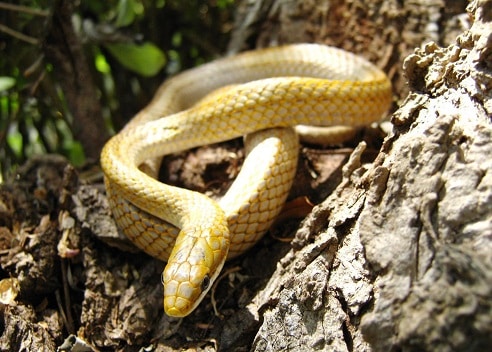
A 40cm snake which preys on grasshoppers and crickets. This harmless species lives in Mexico’s Yucatán peninsula, coexisting with central American coral snakes and menacing Tzabcan rattlesnakes. This is another species which knows its limits and enjoys a peaceful undercover life of disguise.
Yucatán white-lipped snakes (Symphimus mayae) live in dry, thorny forests rather than moist jungles, and are pale white-yellow to match. They perfectly resemble a fallen twig, whereas green or black would give the game away instantly. It helps that few tourists have ever heard of Yucatán white-lipped snakes anyway. They don’t know what they’re looking for, and would walk right past them if they did. They might bump into a Tzabcan rattlesnake, hissing and shaking its tail, and back off slowly, not noticing the hidden Yucatán white-lipped snake eating popcorn and watching the whole thing.
This is a ground snake rather than a tree dweller, and a steady patient character which takes a lot of harassment to get agitated. This belongs to the 2 member Symphimus family, the second being the Mexican white-lipped snake.
| 9 | Sharp-tailed snake |
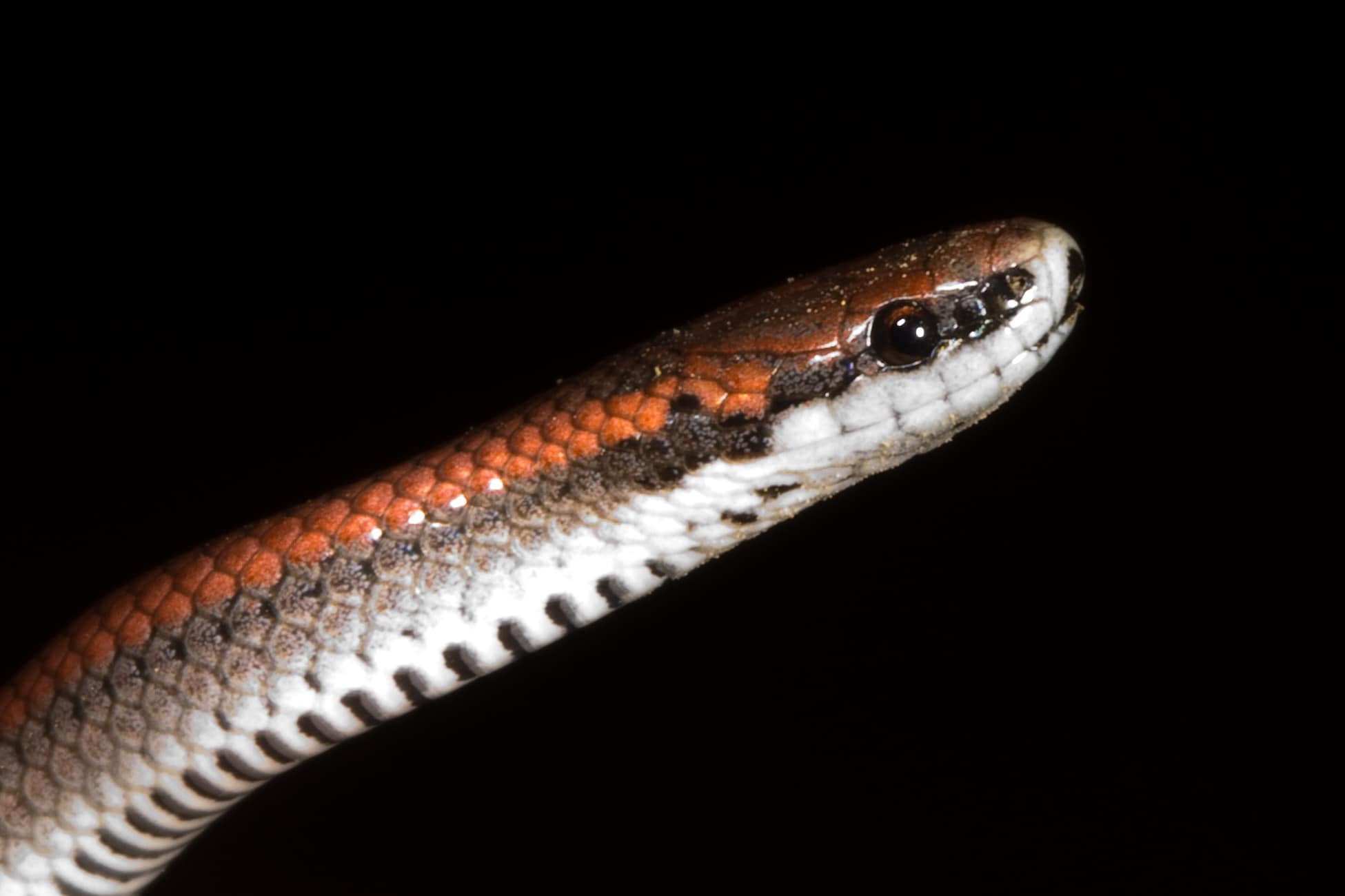
A snake so well-disguised that people walk right past them when there’s 10-15 close by. This is another US snake, but unlike the smooth green snake, which hides in long grass, sharp-tailed snakes absorb themselves into the mulchy forest floor. They blend with the decomposing forest matter of 1000 seasons, a mixture of wet leaves, rotting logs and soil blending into one mixture.
Sharp-tailed snakes inhabit California, Oregon, and Washington state, plus extreme southwest Canada. They have a natural inclination to gather together, and a natural inclination to lurk under cover like a millipede. Combined with an adult length of just 30cm, it’s easy for a forest explorer to walk right past them and not notice anything.
This is during summer, the peak of their activity. In winter, they retreat to deep underground chambers and become straight up impossible to find. Sharp-tailed snakes are harmless to humans except for a pointy tail which they poke you with. They’re slow-moving, and up to 11 have been found together at once. There’s no foolproof way to find a sharp-tailed snake except persistence.
| 10 | Limestone eyelash viper |
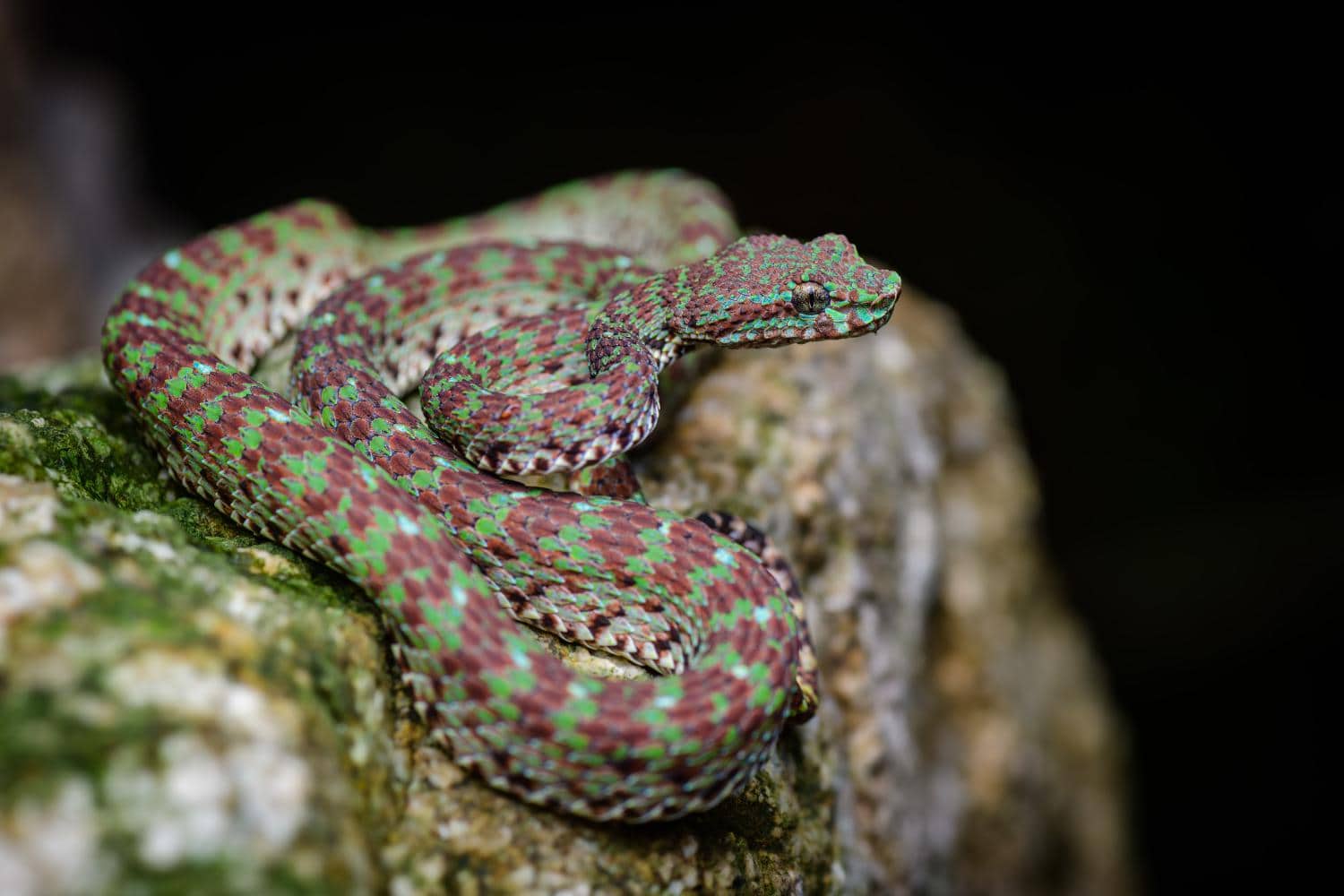
One of the most poorly researched pitvipers in the world. This venomous species has no relation to the eyelash vipers of Central America (Bothriechis family). Instead, they’re just another footsoldier in the vast Trimeresurus pitviper family of southeast Asia. Trimeresurus ciliaris inhabits the Malaysian border regions of extreme southern Thailand, a narrow slice of land. Due to their obscurity, they were only officially discovered by western science in 2023. It’s a rainy, jungled world they’ve found themselves in after the long-winding road of evolution, after diverging from rattlesnakes 10s of millions of years ago.
Limestone eyelash vipers have vertical pupils with a triangular head, and are easy to walk right past because of their complex green colours, and propensity to hide among limestone boulders deep within forests, surrounded by vegetation and leaf litter. This species has juicy red patches as well, but this isn’t enough to prevent it from completely blending into the jungle.
Villagers probably walk past them constantly, while even reptile enthusiasts missed them for decades. This is to the limestone eyelash viper’s advantage, as they’re an ambush predator. They blend with the jungle to avoid the attention of prey, and this has a side effect of humans failing to spot them.
